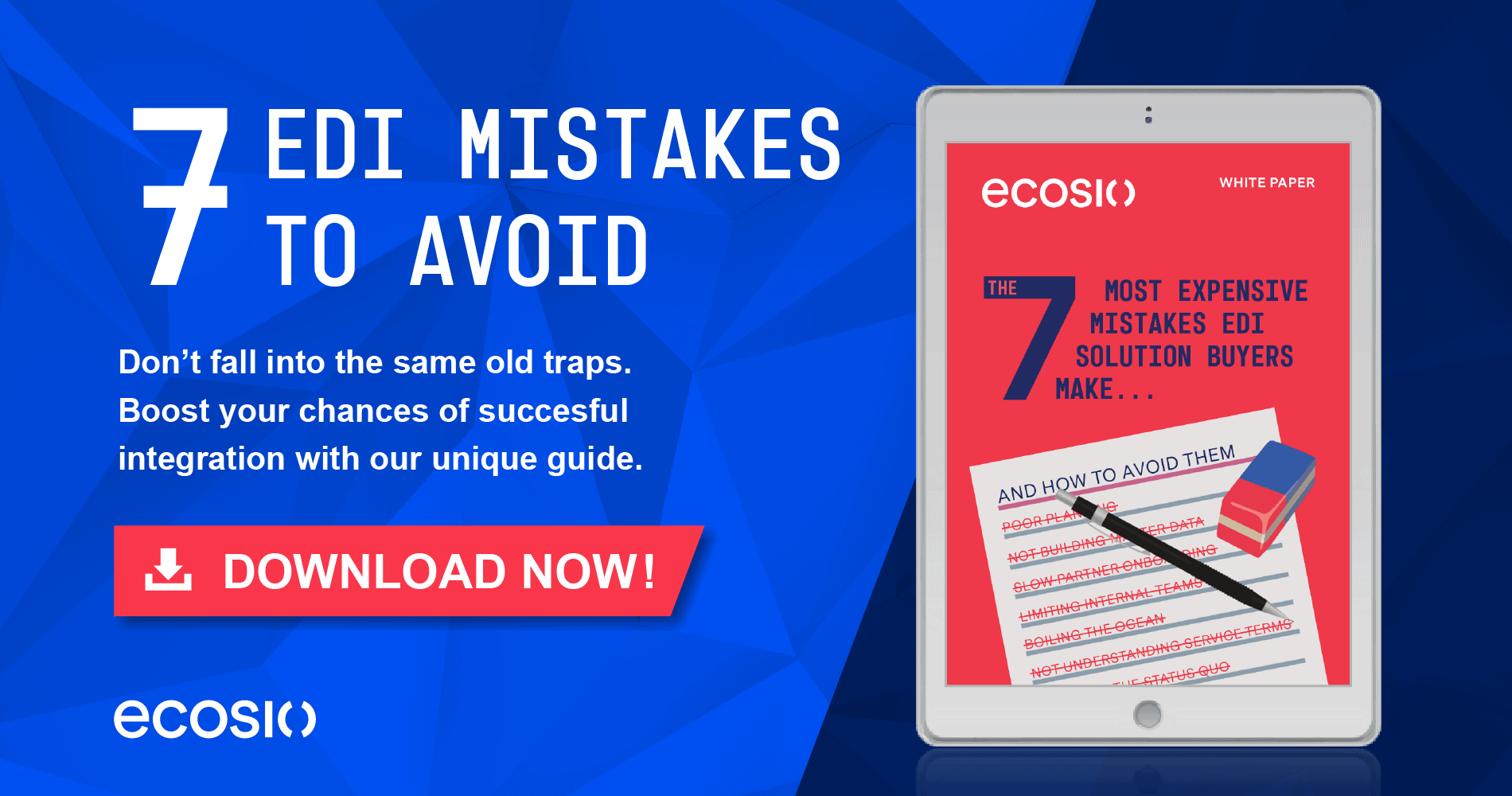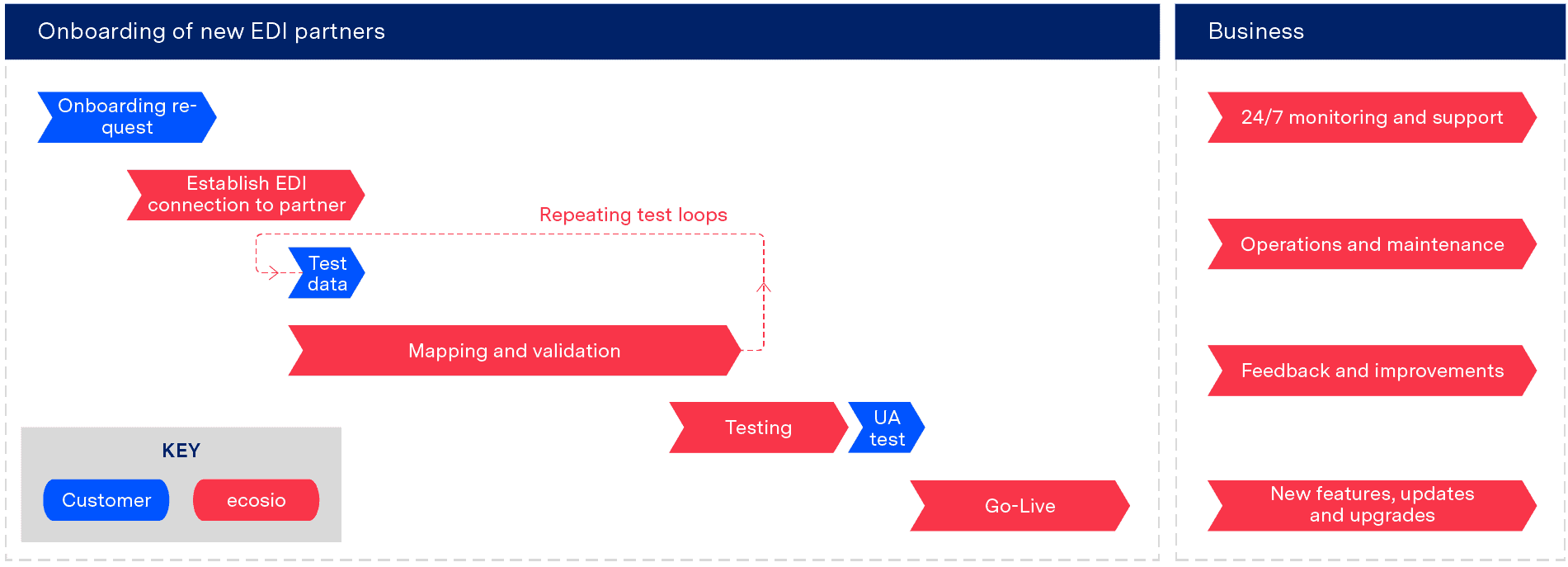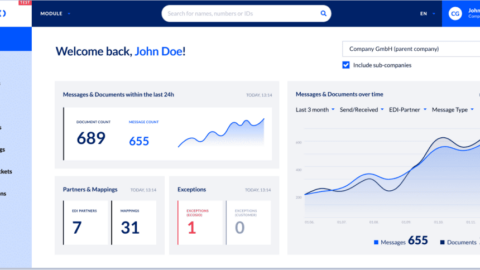Want to streamline your supply chain via EDI implementation but not sure exactly what doing so involves? You’re not alone!
Transitioning to a B2B integration solution that better suits your business’s needs can drastically improve efficiency and costs over the long term. Even when the benefits of upgrading existing B2B processes and providers are well understood, however, many decision makers still put off EDI implementation projects as they mistakenly believe that the process will be long and frustrating. As we will explore, this need not be the case.
In this article we’ll go through the different stages involved in an EDI implementation, shedding light on each step. Hopefully, by the end you will have a clearer picture of what’s required to achieve a successful outcome.
Choosing the right provider
Unsurprisingly, the first step in any successful EDI implementation project is selecting the right provider to move forward with. As EDI contracts are generally fairly long and EDI is integral to the success of supply chain businesses, this process should not be rushed!
Some key questions to ask when assessing and selecting a provider include:
- How much work are you willing to do internally?
- Do you have in-house EDI expertise?
- What are your possible future requirements?
- Do they offer an API connection?
- Are they able to help reduce VAN costs?
- Do they have the necessary certifications?
- Do they have sufficient technical expertise?
- Is the solution user-friendly?
- Do they offer round the clock message monitoring?
- How easy is it to get hold of someone if errors occur?
- Is the solution future-proof?
- Are there hidden costs?
Developing a project strategy
Once you have selected your provider it is then necessary to plan the most suitable strategy for EDI rollout (ideally with input from your new provider). More often than not the most effective method of EDI implementation involves a step-by-step approach to onboarding your partners, although this may not always be possible.
Three key questions to consider at this stage include:
- What is the proposed timeline?
- Are there any external factors that could influence this timeline that should be considered?
- What is the desired outcome?
Once you have agreed the timescale and desired outcome, the next step is to agree what order your partners should be onboarded in. This typically involves considering a number of different factors. These might include (for example):
- A partner’s value to your business
- Number of messages exchanged per month
- The potential for quick cost reduction (e.g. onboarding certain partners might enable you to remove unnecessary VAN costs)
- Urgency (e.g. if a business partner has changed EDI requirements and a new connection needs to be implemented asap)
- Location (e.g. by country)
- Current provider/solution
While your proposed EDI provider may be able to give valuable tips and suggestions to help you order your partners into suitable groups, this process should ideally be led by someone internal with a good knowledge of the partner network. After all – no-one knows your partners and their interaction with your business better than you!
Successful completion of this phase will ensure that you achieve the maximum value from your implementation in as little time as possible.
Connection to your ERP system
Though this step is not necessary for all solutions, it is essential if you want to benefit from good data visibility. An API connection (such as that offered by ecosio) allows for end-to-end message monitoring between you and your suppliers – all in your existing ERP interface, be that D365, NetSuite, SAP S/4HANA or any other system.
Apart from an API connection any other protocol of choice may be used to exchange data between your ERP system and your provider. In such cases AS2 or SFTP are generally the preferred methods. The one-time setup involves establishment and testing of the connection between you and your provider.
Testing and mapping setup
This stage requires significant experience and technical expertise. Essentially the success of this phase dictates the reliability of your partner connections and will determine how much work is required after go-live to correct errors and message failures.
In order to ensure your connections to your partners are dependable, mappings must be set up and tested thoroughly before anything is put live. This involves testing every possible iteration of all relevant document types. For example, oversights such as failing to test the exchange of invoices with and without VAT could cause big headaches following go-live.
As detailed in our useful infographic, the extent of assistance offered by solution providers during this stage varies widely. While those with on-premise solutions will have to conduct all mapping and testing in-house, those who opt for so-called “managed” EDI solutions may only receive basic mapping covering several standard document types. On the other hand, fully managed solution providers will need minimal input from their customers to complete a thorough testing process. Those who opt for such a solution should only be required to provide test data and check that information is correct from a business (not technical) perspective.
Breakdown of the technical steps of an ideal onboarding
Below is a breakdown of the many technical steps involved in a partner onboarding. It should be remembered, however, that while these are all important steps, the amount of assistance you will receive during these phases will vary hugely depending on which solution and provider you select.
| Reconciliation of communication protocols |
|
| Reconciliation of message format |
|
| Exchange of test messages |
|
| Parallel phase |
|
| Live operation |
|
For a more comprehensive overview of the supplier onboarding process, view our article “Supplier EDI Onboarding – The Seven Key Steps” on this topic.
What about ongoing support?
Although an EDI implementation project can be considered “done” once all connections have been put live and are working as expected, it should be remembered that EDI is an ongoing process. To ensure connections continue to function at maximum efficiency message monitoring is essential, while support and error resolution will also be needed from time to time.
If your provider does not offer sufficient support, internal processes must be put in place to ensure you are able to resolve issues quickly and efficiently before problems can escalate.
How ecosio handles EDI implementations
At ecosio we follow a phased approach. With every connection ecosio’s tried and tested process remains constant. The diagram below displays the steps involved in connecting new partners with ecosio.
As illustrated below (click to enlarge), ecosio’s process reduces the input needed from customers to the absolute minimum, both during and after go-live. We take care of everything, leaving businesses free to focus on what they do best!
During EDI implementation
To save you having to act as a middleman between us and your partners, we provide all customers with a dedicated project manager. As well as acting as a single point of contact for the company, they will chase your partners for the information necessary to ensure a strong and reliable connection is secured. All you have to do is provide us with test data.
After go-live
With ecosio, EDI does not end when the turn-key-ready connection is handed over – with us EDI is a continuous process. Customers will no longer have to endure the frustration of seeing cryptic error messages like “stuck in the first level”. ecosio’s operations team is always at hand to identify and resolve errors proactively.
What sets ecosio apart?
- Dedicated experts who are fully committed to EDI.
- Deep EDI process know how – not just EDI message jugglers, but experts, who can challenge an EDI message in detail if necessary.
- Excellent tool support custom-tailored to EDI projects. This facilitates the communication between all EDI partners and also among the EDI project managers and document mappers at ecosio.
- Dedicated test environment and fully functional test-bed, where connections can be tested until they are production-ready.
Find out more
To learn more about how we could help you to benefit from efficient EDI, get in contact today.














